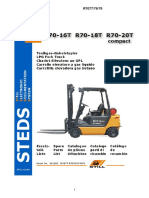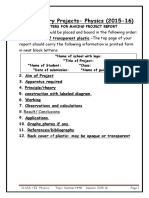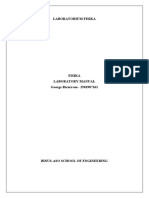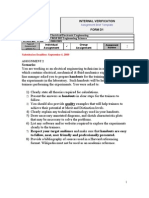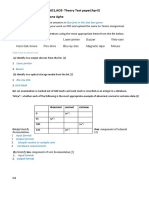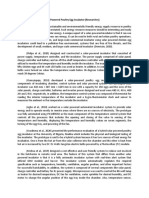Computer-Based Analysis of Electric Stress: Ansys Maxwell 2D
Computer-Based Analysis of Electric Stress: Ansys Maxwell 2D
Uploaded by
samiCopyright:
Available Formats
Computer-Based Analysis of Electric Stress: Ansys Maxwell 2D
Computer-Based Analysis of Electric Stress: Ansys Maxwell 2D
Uploaded by
samiOriginal Description:
Original Title
Copyright
Available Formats
Share this document
Did you find this document useful?
Is this content inappropriate?
Copyright:
Available Formats
Computer-Based Analysis of Electric Stress: Ansys Maxwell 2D
Computer-Based Analysis of Electric Stress: Ansys Maxwell 2D
Uploaded by
samiCopyright:
Available Formats
UNSW - SCHOOL OF ELECTRICAL ENGINEERING AND TELECOMMUNICATIONS
ELEC4611 POWER SYSTEM EQUIPMENT LABORATORY
EXPERIMENT 5
COMPUTER-BASED ANALYSIS OF ELECTRIC STRESS
1. INTRODUCTION
Insulating materials used in power system equipment are subjected to severe electric stress.
Breakdown will occur if the stress exceeds the material breakdown strength. Knowledge of
the electric field distribution in a given insulating structure is important as it enables
determination of the permissible operating voltage and methods of controlling electric stress.
This knowledge can be achieved using computer-based numerical methods such as the Finite
Element Method (FEM) to solve the Laplace’s or Poisson’s field equations. Note that
practical insulating systems usually involve a combination of different insulating materials
with different permittivity and also require solving three-dimensional fields with complex
boundary conditions.
2. EXPERIMENT
This experiment involves the use of computer programs. There are many commercial
software programs for field analysis. One such product is the Ansys Maxwell 2D for two-
dimensional field analysis (www.ansys.com). The workflow process to solve a field problem
involves six steps: create a structure → assign materials → add boundaries → add excitations
→ set up the solution → solve → post processing.
(a) Draw, set up, and solve for the electrostatic field in between two parallel copper plates
(1 mm thickness, 15 mm length) at 5 mm apart with an applied voltage of 1 kV. Verify
that the electric field is uniform.
▪ Starting Maxwell: do one of the following:
- Double-click the ANASYS Electronics Desktop icon on Windows Desktop.
- Use Start menu to select Programs>ANASYS Electronics Desktop
▪ Create a 2D Project:
- From the tool bar Maxwell>Maxwell 2D
The Project Manager window will appear on the left.
To create solution type, do one of the followings:
- Choose Maxwell 2D>Solution Type>Electrostatic
- Right click on Maxwell2Ddesign1 in Project Manager window, then choose
Solution Type and Electrostatic.
Note: You need to set the Solution Type to Electrostatic when you insert a new
project.
▪ Create modeling objects:
In order to draw the above structure (parallel plates), you can follow these steps:
(a) Design the first plate:
- Draw>Line
- In status bar, enter 0 in X box and 0 in Y box.
- Change the coordinate from Absolute to Relative.
- Enter 0 in dX box and 1 in dY box (after this step, you can see a vertical line
with length of 1mm will be drawn).
Elec4611 - Experiment 5: Computer-based analysis of electric stress - Page 1 - 2020
- Enter 15 in dX box and 0 in dY box.
- Enter 0 in dX box and -1 in dY box.
- Enter -15 in dX box and 0 in dY box.
- Right click on design window>Done. After this step, the object will be
automatically named Polyline1.
(b) Design the second plate:
- Repeat part (a) above with appropriate coordination start with 0 in X box and 6
in Y box.
- The plate will be automatically named Polyline2.
(c) Design boundary:
- Draw>Rectangle
- In status bar, enter -20 in X box and 27 in Y box.
- Enter 55 in dX box and -47 in dY box
- It will be named Rectangle1
▪ Defining Materials:
In this step, the materials as well as their characteristics will be assigned to above
created objects.
Choose Polyline1 and Polyline2 objects > Modeler > Assign Material. In materials
tab, choose copper > OK.
▪ Set up Boundaries and Excitation:
(a) Choose Polyline1>Maxwell 2D>Excitation>Assign>Voltage>enter 1000
V>OK
(b) Choose Polyline2>Maxwell 2D>Excitation>Assign>Voltage>enter 0 V>OK
(c) Edit>Selection Mode>Edges.
Hold Ctrl + left click on 4 edges of Rectangle1
>Maxwell 2D>Boundaries>Assign>Balloon>OK.
▪ Generating a Solution
(a) Set up a Matrix Calculation: Maxwell 2D>Parameters>Assign>Matrix>Check
Voltage 1 as Signal Line and Voltage 2 as Ground.
(b) Set up a Solution: Maxwell 2D>Analysis Setup>Add Solution Setup>Leave
these criteria as default.
▪ Checking Validity and Run Simulation:
(a) Maxwell 2D> Validation Check Make sure all steps are checked.
(b) Run simulation: Maxwell 2D>Analyze All.
▪ Monitoring electric stress:
Choose Rectangle1 >Maxwell 2D>Fields>Fields>Mag_E>AllObjects
(b) Consider a right-angled structure as shown in Figure 1:
▪ Obtain the field plot for this structure.
▪ Comment of the results.
▪ Suggest a minor modification that can be done to the structure to reduce the stress.
Redo the plot to verify.
Elec4611 - Experiment 5: Computer-based analysis of electric stress - Page 2 - 2020
5cm electrodes
air
15cm
10kV
0V
Figure 1
Note: The thickness of the above electrodes is 1cm.
(c) A cable, shown in Figure 2, has an eccentric core and axial uniformity. There are 100
kilo-volts across the cable and the insulation has a relative permittivity r = 2.0 and
resistivity = 1013 m. The diameter of cable core and cable are 10 mm and 100 mm,
respectively. The center of cable core is 25 mm away from the center of cable.
▪ Obtain the field plot for this cable using Maxwell 2D.
▪ Determine the stress and voltage at points P1 and P2. Compare simulation results
with those obtained using manual field mapping (see Appendix).
▪ Identify the region of highest stress and determine its value.
▪ Calculate the cable capacitance and insulation resistance (per unit length).
▪ Explain why the lower half plot (in Fig.2) is incorrect.
▪ If this cable is concentric, redo the field plot and determine the highest stress. This
case can also be solved analytically and the electric field at a radius r is given by:
V
E (r ) = V/m
r ln ( b a )
where b is the outer radius, a is the inner radius, and V is the total voltage across the
insulation. Compare the results. Also, compare against that of the eccentric core.
Note: inner circle (cable core) should be subtracted in order to achieve accurate result.
Elec4611 - Experiment 5: Computer-based analysis of electric stress - Page 3 - 2020
Fig.2: (a) curvilinear squares plot for an eccentric cable of constant cross-
section, (b) general curvilinear square and its subdivisions, (c) expanded
view of curvilinear square 2 that forms the ends of a curvilinear cell of
depth d (m).
(d) In many high voltage insulation systems multi-dielectric structures are used with
dielectric materials with different relative permittivity in order to provide better use of
insulation by reducing the overall insulation thickness and making the field more
uniform within the overall layer structure. In other cases, the use of multi-dielectric
structures is unavoidable such as in a HV bushing where the small gap between the
porcelain insulator and the inner HV conductor is normally filled with insulating oil.
Consider the 11 kV model bushing as specified in Experiment 3 with the applied
voltage of 20 kV.
Elec4611 - Experiment 5: Computer-based analysis of electric stress - Page 4 - 2020
▪ Obtain the field plot for the case when the gap is air, and determine the highest
stress by modelling cross section of bushing
▪ Obtain the field plot when the gap is filled with oil, and determine the highest stress
by modelling cross section of bushing
▪ Comment on the results.
3. REFERENCES
1. E. Kuffel, W.S. Zaengl, and J. Kuffel, High Voltage Engineering: Fundamentals, 2nd
ed., Butterworth-Heinemann, 2000.
2. Ansoft Corporation, Getting Started: A 2D Electrostatic Problem, Maxwell 2D
Student Version, 2002.
Elec4611 - Experiment 5: Computer-based analysis of electric stress - Page 5 - 2020
4. APPENDIX – FIELD ANALYSIS BY MANUAL FIELD MAPPING
To solve a field problem, we need to obtain the flux or potential distribution. From this, we
can obtain the required macroscopic and microscopic properties
e.g. R, C, L , J , D , B , E , etc
There are three methods of obtaining flux and potential distribution:
1. ( )
Solve Laplace’s equation 2 = 0 or Poisson’s equation 2 = − ( )
analytically or numerically
2. Manual field mapping
3. Numerical iteration
Field mapping
This technique uses known field properties to draw up a map of the field for a particular
configuration. It can give surprisingly accurate results.
Field properties:
(i) Flux lines and equi-potentials are orthogonal
(ii) Surfaces of flux sources are equi-potentials
(iii) Flux lines intersect sources and sinks orthogonally.
The aim is to divide the field structure into curvilinear squares (assuming there is symmetry in
the third dimension)
If the element is part of current flow and the current density is J , and electric field E
I = J area = J ( x ) = J x ( =1 m )
V = E y
Hence, resistance of the elemental section is:
Elec4611 - Experiment 5: Computer-based analysis of electric stress - Page 6 - 2020
V E y 1 y 1
R = = = = = if = 1m and y = x
I J x x
Thus, each curvilinear square of unit depth has resistance . The total resistance can be
obtained by counting squares in the full map.
This holds for any field, the only difference being the property relative to the field type, e.g.
▪ For an electric field, capacitance of the unit square =
▪ For a magnetic field, the unit square inductance =
▪ For a thermal field, the unit square conductance = k
e.g. for a current flow field above, if there are n equipotential drops and m flux tubes of
current and the resistivity is , then the total R is:
n
R= ohms
m
4
In the above: n = 4, m = 8 R = = ohms (per m)
8 2
If a capacitance:
= Q and total Q = mQ = 8Q
= V and total V = nV = 4V
Hence:
Q 8 Q
Total C = = = 2 (F/m)
V 4 V
For flux density and potential gradient, use the appropriate single square and the applicable
scale factor of the map:
Flux density =
1 x
m
= =
x x
n
Pot. grad = =
y y
Thus if we know total and and get m and n, and x ( =y ) from the map, we can find
x and y .
__________________________
Elec4611 - Experiment 5: Computer-based analysis of electric stress - Page 7 - 2020
You might also like
- User's Manual: AssistDocument102 pagesUser's Manual: AssistMV Fran75% (8)
- Electrostatically Actuated Cantilever: Created in COMSOL Multiphysics 6.0Document18 pagesElectrostatically Actuated Cantilever: Created in COMSOL Multiphysics 6.0Esau PalaciosNo ratings yet
- High Voltage Technology Module (Question and Answer)Document382 pagesHigh Voltage Technology Module (Question and Answer)razifhamzah95% (21)
- EE340 Lab ManualDocument31 pagesEE340 Lab ManualAhmed Al-Shwmi100% (1)
- Treibgasstapler R7077/78/79Document223 pagesTreibgasstapler R7077/78/79Petr100% (5)
- Bridge Condition Rating Data Modeling Using Deep Learning AlgorithmDocument15 pagesBridge Condition Rating Data Modeling Using Deep Learning AlgorithmPalisa Arafin100% (1)
- ELEC4611-24 Exp 5Document7 pagesELEC4611-24 Exp 5qumg3hsNo ratings yet
- 1908 AnsysDocument5 pages1908 AnsysAndrés Felipe Méndez-ArenasNo ratings yet
- Phy Part I AssignmentDocument16 pagesPhy Part I Assignmentketan waghNo ratings yet
- Instructions: Solve The Assignment Question in The Space Provided. Make Diagrams/illustrations Wherever NecessaryDocument9 pagesInstructions: Solve The Assignment Question in The Space Provided. Make Diagrams/illustrations Wherever Necessarysardar talhaNo ratings yet
- Project Electrostatics ProblemDocument18 pagesProject Electrostatics ProblemAndreea Ioana MateescuNo ratings yet
- Lab 5 Multisim TutorialDocument9 pagesLab 5 Multisim TutorialMuhammad UbaidNo ratings yet
- Problems 3Document11 pagesProblems 3ansat5.ansatNo ratings yet
- Exp 3Document5 pagesExp 3MariaNo ratings yet
- Solution Manual-2nd EdDocument55 pagesSolution Manual-2nd EdSami Rajput50% (2)
- 2016 TestDocument12 pages2016 Testhenry.yapeterNo ratings yet
- Lab 7 - Voltage MultiplierDocument2 pagesLab 7 - Voltage Multiplieregaupc2123No ratings yet
- Sen 544 L2&3Document66 pagesSen 544 L2&3Atef AlanaziNo ratings yet
- Final Exam 2022Document2 pagesFinal Exam 2022Badr BouhsinaNo ratings yet
- (Chapter 24) : Gauss's Law Problems and Quiz QuestionsDocument7 pages(Chapter 24) : Gauss's Law Problems and Quiz Questionsmohammed .muddassirNo ratings yet
- ENEL2ED2H2Document5 pagesENEL2ED2H2chettytrisan324No ratings yet
- Ece 331 Lab Manual Spring 2021Document86 pagesEce 331 Lab Manual Spring 2021haiderNo ratings yet
- Capacitance (George Ricarrson - 2501987261)Document12 pagesCapacitance (George Ricarrson - 2501987261)George RYNo ratings yet
- Diff Ass1 PDFDocument8 pagesDiff Ass1 PDFshashankNo ratings yet
- Models - Acdc.superconducting WireDocument14 pagesModels - Acdc.superconducting WireDaniel DolingNo ratings yet
- ECE 2262 - Fundamentals of Electronic Circuits - Module 3Document4 pagesECE 2262 - Fundamentals of Electronic Circuits - Module 3Rafael Jayson AñoraNo ratings yet
- Prework Questions For KI-1Document5 pagesPrework Questions For KI-1Danial SadiqNo ratings yet
- EET201Question and AnswersDocument19 pagesEET201Question and Answerssahalavalappil5No ratings yet
- ENEL2EBH2Document7 pagesENEL2EBH2chettytrisan324No ratings yet
- Ihw 3Document9 pagesIhw 3LogoNo ratings yet
- 40C Lab 2 EquipotMap9Document7 pages40C Lab 2 EquipotMap9ibeupupandawayNo ratings yet
- ECEN 326 Lab 2 - Diode RectifierDocument7 pagesECEN 326 Lab 2 - Diode Rectifierswercz03No ratings yet
- THE Simulation Study of DC Grounding Electrode BasDocument6 pagesTHE Simulation Study of DC Grounding Electrode BasFOGNo ratings yet
- ELN 131 Lab1 DiodesDocument6 pagesELN 131 Lab1 DiodesSarah ShermanNo ratings yet
- Lab#11 EEDocument16 pagesLab#11 EEJunaid KhalidNo ratings yet
- Scenario:: Internal Verification Form D1Document10 pagesScenario:: Internal Verification Form D1tanmoyr2001No ratings yet
- Asya Baş - İdil Gürsoy - Nehir Huriye Öztürk PDFDocument8 pagesAsya Baş - İdil Gürsoy - Nehir Huriye Öztürk PDFasyabas03No ratings yet
- models.rf.parallel_wires_impedanceDocument16 pagesmodels.rf.parallel_wires_impedanceGabriel PinoNo ratings yet
- Models - Mems.electrostatically Actuated CantileverDocument18 pagesModels - Mems.electrostatically Actuated CantileverMendoza Poma Elsner WalterNo ratings yet
- Potkrajac PaperDocument5 pagesPotkrajac PapergrothendiecknkcocNo ratings yet
- Self Bias 3Document17 pagesSelf Bias 3Chen Chee JungNo ratings yet
- Control Systems Group Project 2Document3 pagesControl Systems Group Project 2Yu-Yun ChangNo ratings yet
- Sample Paper-2011 Class - XII Subject - Physics: Electrostatics)Document3 pagesSample Paper-2011 Class - XII Subject - Physics: Electrostatics)Swati BansalNo ratings yet
- 12th Physics Unit 1 and 2 Question Paper English Medium PDF DownloadDocument2 pages12th Physics Unit 1 and 2 Question Paper English Medium PDF Downloadabdulrahmanba36No ratings yet
- PHY-301 Assignment 1 Solution FileDocument5 pagesPHY-301 Assignment 1 Solution Filezaheerawais2No ratings yet
- UNITTEST_D20-Dec-2024-2Document2 pagesUNITTEST_D20-Dec-2024-2ashish10122006No ratings yet
- Experiment No.:2: Elec 20001 - Ac Electrical Circuit AnalysisDocument8 pagesExperiment No.:2: Elec 20001 - Ac Electrical Circuit AnalysisramNo ratings yet
- Experiment - 2 Simulation and Real-Time Implementation of A Switch-Mode DC ConverterDocument14 pagesExperiment - 2 Simulation and Real-Time Implementation of A Switch-Mode DC Convertereng_abdelghany1979No ratings yet
- 77 CapacitanceDocument8 pages77 Capacitance수효주No ratings yet
- Experiment - CapacitanceDocument8 pagesExperiment - Capacitancemuzahir.ali.baloch2021No ratings yet
- EMFT Project - Multilayer Coax CapDocument2 pagesEMFT Project - Multilayer Coax Capmisterrio2022No ratings yet
- Maxwell v16 L04 Static Electric SolversDocument19 pagesMaxwell v16 L04 Static Electric SolversVahidJamNo ratings yet
- 2018 TestDocument10 pages2018 Testhenry.yapeterNo ratings yet
- 2017 TestDocument13 pages2017 Testhenry.yapeterNo ratings yet
- Asya Baş - İdil Gürsoy - Nehir Huriye Öztürk PDFDocument7 pagesAsya Baş - İdil Gürsoy - Nehir Huriye Öztürk PDFasyabas03No ratings yet
- Electric Field Analysis of Hvac Testing UnitDocument5 pagesElectric Field Analysis of Hvac Testing UnitVenkata Krishna ReddyNo ratings yet
- ECE462 Motor Lab Experiment2Document14 pagesECE462 Motor Lab Experiment2RamKumarNo ratings yet
- Mesh Solution With 2 SourcesDocument4 pagesMesh Solution With 2 SourcesNATHANIEL OLSEN PARRENASNo ratings yet
- EXP-6 BJT ApplicationsDocument6 pagesEXP-6 BJT ApplicationszaidNo ratings yet
- Eps Lab ManualDocument31 pagesEps Lab Manualpspramila2002No ratings yet
- Design of Electrical Circuits using Engineering Software ToolsFrom EverandDesign of Electrical Circuits using Engineering Software ToolsNo ratings yet
- Electromagnetic Compatibility (EMC) Design and Test Case AnalysisFrom EverandElectromagnetic Compatibility (EMC) Design and Test Case AnalysisNo ratings yet
- Feynman Lectures Simplified 2C: Electromagnetism: in Relativity & in Dense MatterFrom EverandFeynman Lectures Simplified 2C: Electromagnetism: in Relativity & in Dense MatterNo ratings yet
- JP 4.3 10M DMRXM SF12 3.8G - 16 - 20231024Document1 pageJP 4.3 10M DMRXM SF12 3.8G - 16 - 20231024jacunaNo ratings yet
- ICS2ODocument2 pagesICS2OSamNo ratings yet
- QUOT PM 1000 LX902741 & Performance Test MergeDocument5 pagesQUOT PM 1000 LX902741 & Performance Test MergeEdy AntoNo ratings yet
- Technical Requirements DocumentDocument7 pagesTechnical Requirements DocumentsatriapratamaNo ratings yet
- The Art of Instrumentation & Vibration AnalysisDocument64 pagesThe Art of Instrumentation & Vibration AnalysisfrajaprNo ratings yet
- SRF04 Technical DocumentationDocument4 pagesSRF04 Technical Documentationt8823pc100% (1)
- Petroleum Production Engineering IDocument119 pagesPetroleum Production Engineering IMurtez100% (2)
- 5 6163286655399626112Document23 pages5 6163286655399626112Taniya SahaNo ratings yet
- Moxa 5150A Data SheetDocument7 pagesMoxa 5150A Data SheetDhanush MSNo ratings yet
- 10 KW HybridDocument1 page10 KW HybridGUL RAHMANNo ratings yet
- User Manual of IPS-DM360HD-HDocument86 pagesUser Manual of IPS-DM360HD-Htonimiy942No ratings yet
- Meltwater Full Userguide2021 UpdatedDocument16 pagesMeltwater Full Userguide2021 UpdatedLi ZhangNo ratings yet
- Unit 3 CNDocument8 pagesUnit 3 CNankitprajapat403No ratings yet
- Year 11 IGCSE 0417 Theory PaperDocument7 pagesYear 11 IGCSE 0417 Theory PaperAmelia RozenNo ratings yet
- Review On Fashion Trend Analysis and Forecasting Techniques - A Machine Learning ApproachDocument6 pagesReview On Fashion Trend Analysis and Forecasting Techniques - A Machine Learning Approachaswnss.mNo ratings yet
- ZOOM MS 50G - OperationmanualDocument32 pagesZOOM MS 50G - OperationmanualArmando ZanforlinNo ratings yet
- Recent Development in Solar Powered Poultry Egg Incubator (Researches)Document4 pagesRecent Development in Solar Powered Poultry Egg Incubator (Researches)Ronaldo MaañoNo ratings yet
- VXA-150 Service ManualDocument32 pagesVXA-150 Service ManualjordiNo ratings yet
- 1-Creator's Field Guide To Emerging Careers in Interactive 3D (01-25)Document25 pages1-Creator's Field Guide To Emerging Careers in Interactive 3D (01-25)Antoni WójcikNo ratings yet
- List Alat DopDocument2 pagesList Alat Dopmuayyedboys95No ratings yet
- Tutorial 02Document1 pageTutorial 02Tussank GuptaNo ratings yet
- SD Process Advance PaymentDocument17 pagesSD Process Advance PaymentAnaIonelaMoldovanNo ratings yet
- SM 35Document49 pagesSM 35Lucas VidoNo ratings yet
- A Two-Port Network Is An Electrical Network With Two Separate Ports For Input and Output. Fig (A) - Single Port Network Fig (B) - Two Port NetworkDocument30 pagesA Two-Port Network Is An Electrical Network With Two Separate Ports For Input and Output. Fig (A) - Single Port Network Fig (B) - Two Port Networklohith sNo ratings yet
- Caleidoscopio – Gene Koshinski (Updated) Sheet music for Marimba (Solo) Musescore.com 2Document1 pageCaleidoscopio – Gene Koshinski (Updated) Sheet music for Marimba (Solo) Musescore.com 2mateopapereaterNo ratings yet
- Camella Homes-1Document1 pageCamella Homes-1Jake DolleteNo ratings yet
- Customer Acquisition Strategies in CRM: 1) Preparation of Prospect ListDocument3 pagesCustomer Acquisition Strategies in CRM: 1) Preparation of Prospect ListArjun SanghviNo ratings yet




